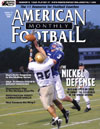AMERICAN FOOTBALL MONTHLY THE #1 RESOURCE FOR FOOTBALL COACHES
Article CategoriesAFM Magazine
|
Why The Spread? 11 Questions For A Coach To Considerby: Jeff HancockOffensive Coordinator/QB Coach, Adrian College by: Jay Osborne Wide Receiver Coach, McMurry University, Abilene, TX © More from this issue One of the greatest joys for me as a football coach is having guys that I have coached get involved in coaching after they graduate. I have been fortunate to have more than one decide to take this career path in the 14 years that I have coached. The most recent addition to this list is Jay Osborne who was recently hired as the wide receiver coach at McMurry University. Jay played in a spread offense for me a few years ago and I as a coach got to watch him grow in his knowledge of the spread offense over the course of his playing career. As he enters his first season as a coach he has posed some questions for me about the spread offense. The following are some of those questions that Coach Osborne has asked me since he has started in his new job that I have attempted to answer. I, in turn, had a few questions for Coach Osbo....The full article can only be seen by subscribers. Subscribe today!
|
|
|||||||
| HOME |
MAGAZINE |
SUBSCRIBE | ONLINE COLUMNISTS | COACHING VIDEOS |
Copyright 2025, AmericanFootballMonthly.com
All Rights Reserved





